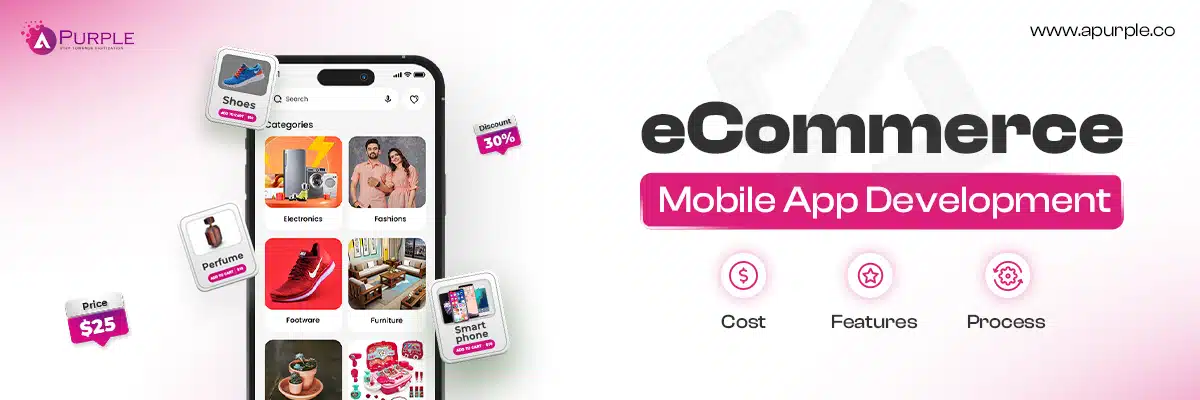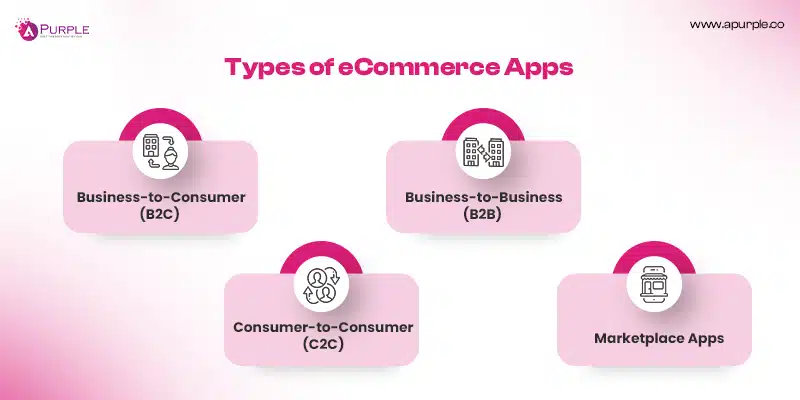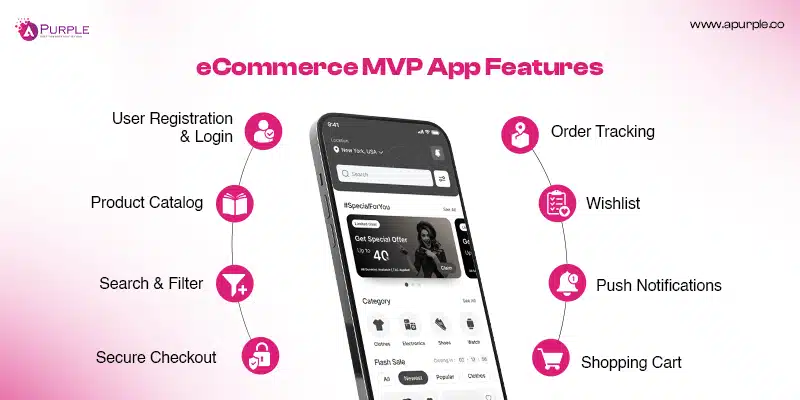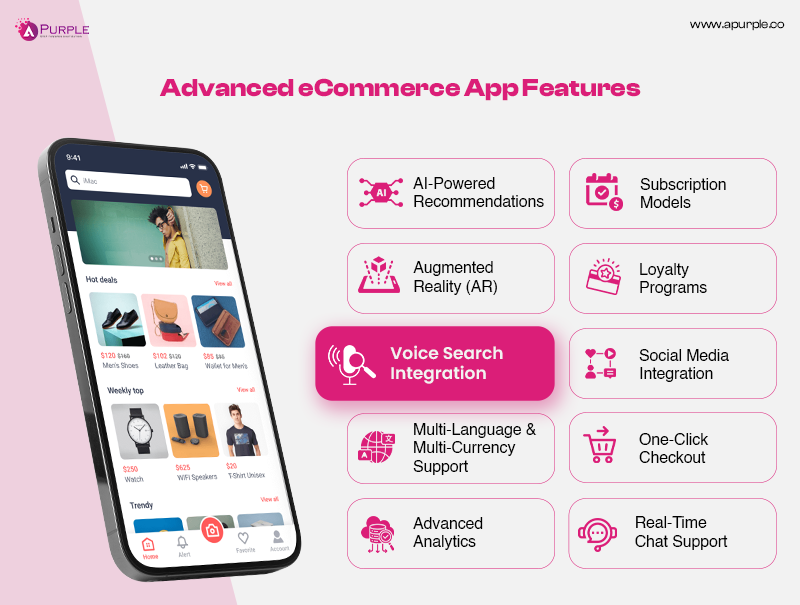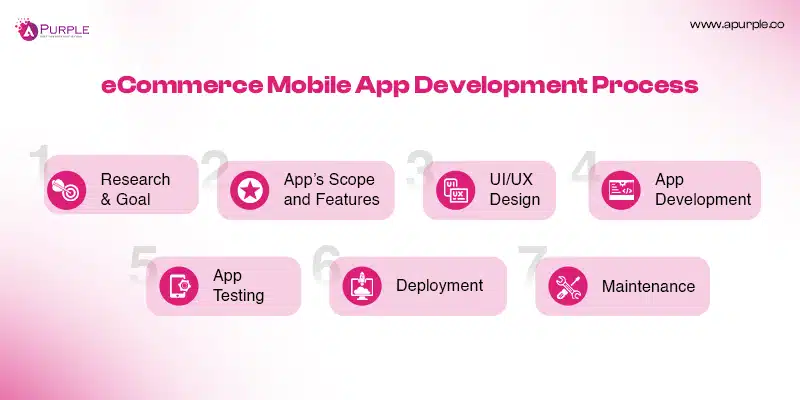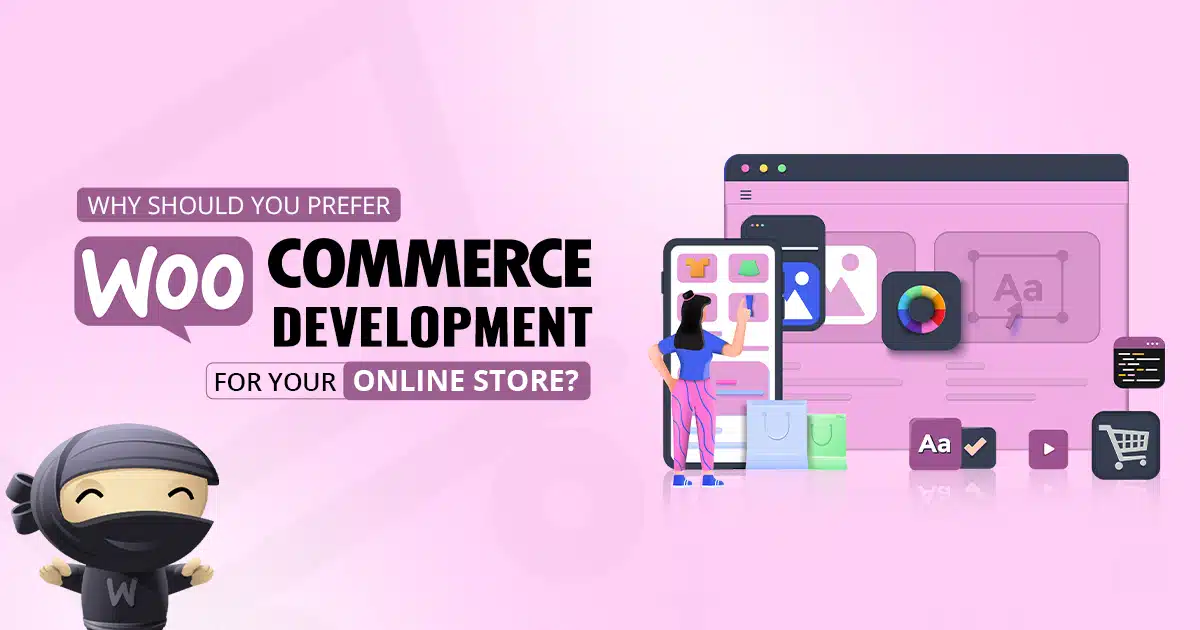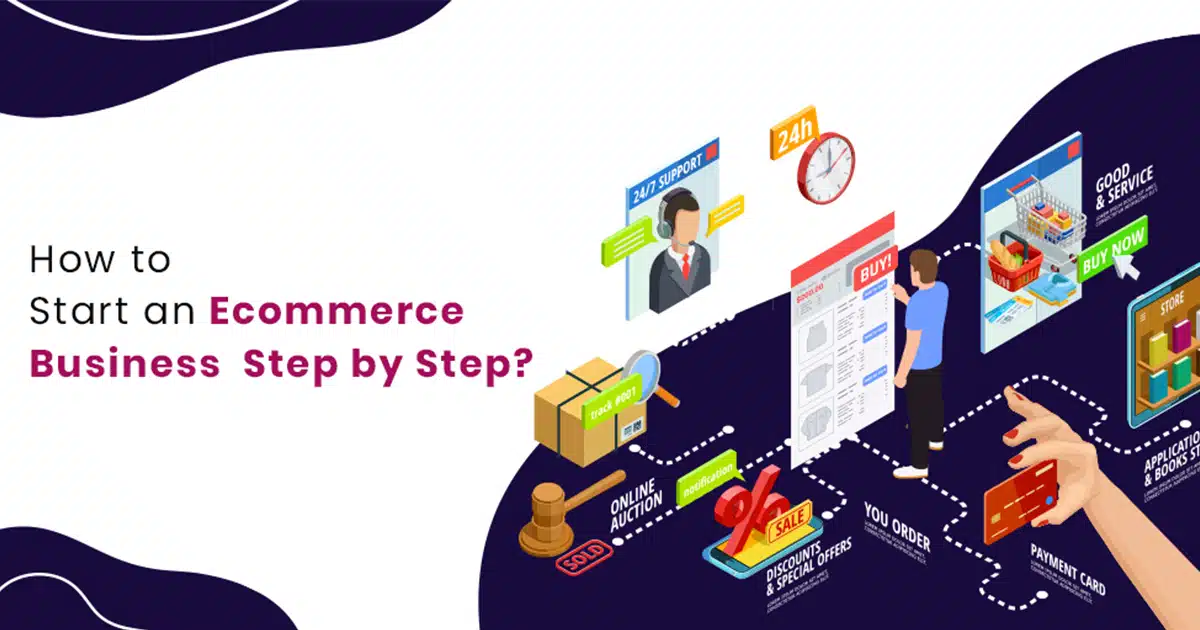Summary: eCommerce mobile app development has revolutionized the way businesses connect with their customers. Learn about development costs, best practices, and how to build an eCommerce app that creates a seamless shopping experience to drive customer engagement and sales.
Imagine a customer searching for a last-minute holiday gift, opening your e-commerce app, and finding exactly what they need in minutes.
The right e-commerce app not only simplifies shopping but also ensures customer satisfaction and loyalty. Apps like Amazon and Etsy have set high standards by combining user-friendly interfaces with innovative features like personalized recommendations and quick checkout processes.
If you’ve come to read this blog, it means you know exactly the profits that an eCommerce mobile application development comes with.
In this piece, we’ll uncover some key strategies to start an eCommerce business, delve into the costs of development, and share best practices to help your app stand out in a competitive market.
Wait, let’s first get a market overview of eCommerce mobile app development.
Market Overview – eCommerce Mobile App and Its Development
The e-commerce industry has seen a meteoric rise, and mobile apps have played a pivotal role in this growth. As consumers increasingly turn to their smartphones for shopping, the demand for robust and user-friendly e-commerce mobile apps continues to surge.
- The e-commerce app market is projected to grow at a CAGR of 9.6% from 2024 to 2029, indicating robust expansion as more consumers turn to mobile for shopping needs.
- By 2027, the global e-commerce market is anticipated to reach USD 7.9 trillion, with mobile devices accounting for 72% of sales. In 2024, mobile e-commerce already represented 5%9 of global sales, highlighting the critical role of mobile apps in retail.
- A significant 30% of smartphone users report making purchases on their devices at least once a week.
- Global eCommerce sales are expected to reach USD 6.3 trillion in 2024.
Now you know the exact demand for eCommerce mobile app development services in the market. However, before heading to the other aspects of the eCommerce app, let’s understand some key aspects of building a shopping app.
Key Aspects to Look Into Before Building an eCommerce App
Everything that is done with planning gives you better results. The same goes for custom eCommerce app development as well. Therefore, we have come up with some major steps that you must take to develop your eCommerce.
1. Types of eCommerce Applications
It is the very first step in mobile commerce app development. The type of eCommerce app you choose will define its scope, functionality, and target audience. Common types include:
1. Business-to-Consumer (B2C)
- Description: Platforms connecting businesses directly with consumers.
- Examples: Amazon, eBay.
- Key Features: Product catalogs, payment gateways, reviews, and delivery tracking.
2. Business-to-Business (B2B)
- Description: Apps facilitating transactions between businesses.
- Examples: Alibaba, ThomasNet.
- Key Features: Bulk pricing, RFQ (Request for Quotation) systems, and supply chain management.
3. Consumer-to-Consumer (C2C)
- Description: Platforms allowing individuals to sell to other individuals.
- Examples: Etsy, Poshmark.
- Key Features: Secure payment options, communication tools, and dispute resolution.
4. Marketplace Apps
- Description: Multi-vendor platforms where several sellers offer their products to consumers.
- Examples: Flipkart, Walmart.
- Key Features: Vendor dashboards, buyer management, and order tracking.
Choosing the right type depends on your target audience, business model, and revenue goals.
2. Technology Stack and Platform Selection
The technology stack determines the performance, scalability, and user experience of your app. The stack that you choose for your eCommerce mobile application development process lets you determine the timeline, cost, and complexity of your project. Besides, make sure that your technology stack aligns with your app’s complexity, expected traffic, and growth plans.
Here is a tech stack list from our end!
1. Front-End Technologies
- Frameworks like React, Angular, or Vue.js ensure a responsive and user-friendly interface.
- Cross-platform tools like Flutter or React Native reduce time-to-market.
2. Back-End Technologies
- Use robust frameworks like Node.js, Django, or Ruby on Rails for scalable server-side solutions.
- Cloud services like AWS or Google Cloud for reliable storage and processing power.
3. Database Management
- Choose relational databases like MySQL or PostgreSQL for structured data.
- Use NoSQL databases like MongoDB for flexible and dynamic data storage.
4. Platform Selection
- iOS and Android: Native development ensures superior performance.
- Cross-Platform: Ideal for reaching a broader audience quickly.
- Progressive Web Apps (PWAs): Combine web and app functionalities to reduce costs.
3. Third-Party Integration
Integrating third-party tools can streamline operations and enhance user experience.
1. Payment Gateways
- Secure eCommerce payment gateway integration options like PayPal, Stripe, or Razorpay ensure trust and reliability.
- Support multiple payment methods, including credit cards, wallets, and UPI.
2. Analytics and Tracking
- Tools like Google Analytics or Mixpanel provide insights into user behavior and sales trends.
- Heatmaps can help understand app usage patterns.
3. Logistics and Shipping
- APIs like FedEx, DHL, or ShipRocket enable real-time order tracking and automated shipping processes.
- Integration with fulfillment services can streamline delivery operations.
4. Marketing and CRM
- Integrate with email marketing tools like Mailchimp or HubSpot for automated campaigns.
- Use customer engagement tools like Zendesk for improved support.
5. Social Media
- Enable social login and share buttons for better engagement.
- Integrate advertising platforms like Facebook Ads or Instagram Shopping.
The next step is to build a list of features for your MVP eCommerce app development and advanced features that you might integrate soon.
eCommerce Mobile App Features
We’ve divided the list of feature sets for eCommerce application development into two sections. The first section is about MVP features, and the second is about advanced features. Let’s get into both categories.
MVP Features for eCommerce App
First, we’ve mentioned some features that go perfectly with MVP app development. Once users start liking your app, keep updating the advanced features.
- User Registration & Login – Enable seamless sign-ups via email, phone, or social accounts.
- Product Catalog – Showcase products with detailed descriptions, images, and pricing.
- Search & Filter – This allows users to find products quickly using category filters and keywords.
- Shopping Cart – Provide an easy way for customers to review and edit selected items before purchase.
- Secure Checkout – Ensure a smooth, multi-step payment process with data encryption.
- Order Tracking – Keep customers updated on their order status in real-time.
- Wishlist – Let users save products for future purchases.
- Push Notifications – Engage users with alerts on deals, order updates, or product launches.
Advanced Features for eCommerce App
This set of advanced features gives your app an extraordinary feel that is different from a normal app. Henceforth, if people like your eCommerce app then keep upgrading it with these advanced features.
- AI-Powered Recommendations – Use AI to suggest products based on browsing and purchase history.
- Augmented Reality (AR) – Allows users to visualize products in real-world settings before buying.
- Voice Search Integration – Facilitate hands-free product searches with voice commands.
- Multi-Language & Multi-Currency Support – Cater to a global audience with localized experiences.
- Advanced Analytics – Offer insights into user behavior, sales trends, and app performance.
- Subscription Models – Include recurring payment options for subscription-based products or services.
- Loyalty Programs – Reward users with points, discounts, or special perks for consistent shopping.
- Social Media Integration – Enable easy sharing and logging in through popular social platforms.
- Real-Time Chat Support – Provide instant assistance with in-app customer service tools.
- One-Click Checkout – Simplify the buying process for returning customers.
This combination of MVP and advanced features ensures your eCommerce app delivers both essential functionality and immense capabilities.
How to Develop an eCommerce Mobile App?
The mobile eCommerce app development process enables you to build your project successfully and in an appropriate period. With such a mobile app development process, you can stay aware of the project timelines and check on its progress. Here are a few crucial steps that come under the eCommerce development process for mobile.
1. Market Research and Requirement Analysis
Before starting, it’s essential to understand your target audience, market trends, and competitors. Identify your app’s unique selling points (USPs) and define its core objectives. This stage involves gathering user needs, analyzing competitors, and listing must-have features.
2. Define the App’s Scope and Features
Once you have a clear market understanding, outline your MVP mobile app development features and any advanced functionalities. Decide whether you want basic features like product catalogs and shopping carts or advanced features like AI-driven recommendations and AR for product visualization.
We’ve mentioned the basic and advanced features of the eCommerce app in the above section.
3. UI/UX Design of eCommerce App
Always note that UI/UX design services for any mobile app play a major role in its success. Henceforth, creating a user-friendly and easy navigation of app design trends is appropriate to hold on to the users. Wireframing and prototyping help you visualize the app’s structure and test the user journey before actual development begins.
The three basic steps for UI/UX design for an eCommerce app include,
- Wireframes: Create basic layouts to visualize app structure and navigation.
- Prototypes: Develop interactive models to test user flow and gather feedback.
- Design Principles: Focus on simplicity, branding, responsiveness, and minimal loading times.
The ultimate result is a polishede-Commerce app UI/UX design that aligns with the brand image and delivers a smooth user experience.
4. The Crucial Part – eCommerce App Development
This phase involves actual coding for the front-end, back-end, and integrating third-party APIs. Developers create the app’s architecture and ensure the functionality aligns with the planned design and scope. Agile app development often helps in ensuring flexibility and rapid iteration during this stage.
- Frontend: It focuses on the app’s interface and ensuring it is visually aligned with the design.
- Backend: The team builds the server’s side backend components, APIs, and database infrastructure.
- Third-Party Integration: Various third-party integrations based on the requirements.
5. Testing and Quality Analysis
Before launching your eCommerce app, rigorous testing ensures the app is free of bugs and delivers a flawless user experience. This includes functional testing, performance testing, security checks, and compatibility tests for multiple devices and platforms.
6. Deployment and Maintenance
Both Android and iOS platforms come with their own set of guidelines and rules for deployment to respective App Stores. Besides that, leverage app store optimization (ASO), social media, and email campaigns to drive initial downloads. Also, Integrate features that allow users to submit feedback easily.
Development doesn’t stop after deployment. Regular updates, bug fixes, and new feature additions based on user feedback are critical for maintaining app performance and relevance in a competitive market.
Okay, that was all about eCommerce mobile app development. But one of the most important questions that we always get from our clients is about the difference between custom eCommerce apps vs ready-made apps. Let’s get into it!
Check out our latest portfolio on the eCommerce marketplace app. Feel free to contact us for your queries!
Custom eCommerce App Vs. Ready-Made Solution
Get all your answers about custom eCommerce apps vs ready-made apps via the table given below. Besides, get in touch with our experts for more information.
| Feature | Custom eCommerce App | Ready-Made Solution |
|---|---|---|
| Development Time | Requires more time due to tailored design and development. | Quicker to set up, often ready for immediate use. |
| Cost | Higher initial investment but offers long-term scalability. | Lower upfront costs but may incur recurring fees. |
| Customization | Fully customizable to match specific business needs. | Limited customization; relies on pre-built templates. |
| Scalability | Easily scalable to accommodate growth and complex features. | Scalability depends on the platform’s restrictions. |
| Unique Branding | Enables unique UI/UX and personalized branding. | Standardized look and feel with limited differentiation. |
| Third-Party Integrations | Seamless integration with any tool or API of your choice. | Restricted to available plugins or integrations. |
| Ownership | Full ownership of code and data. | Ownership is often limited or shared with the provider. |
| Maintenance and Support | Requires dedicated resources for updates and fixes. | Provider handles updates, but limits control over changes. |
Pro Tip – Turn Your eCommerce Vision Into Reality with our Amazon Clone!
Custom eCommerce apps have an edge over ready-made solutions, offering reduced development time, cost, customization, and scalability. But what makes custom apps far more attractive than a ready-made solution is the ease of integration.
For example, you can easily integrate artificial intelligence capabilities into your apps with a custom solution.
How to Integrate AI in ECommerce Apps?
Integrating AI in eCommerce apps requires a structured approach that balances business goals, technical readiness, and customer experience. AI integration in eCommerce apps can help you enable personalized shopping experiences, automate customer services, and leverage dynamic pricing.
Such benefits, along with the integration of other technologies like AR/VR, NLP, and ML, have led to the rise of eCommece 2.0. However, leveraging eCommerce 2.0 for your applications requires a step-by-step process that integrates AI algorithms and develops advanced features.
Here is the process for interacting with AI in eCommerce.
Step 1: Define The Need For AI
The first step in integrating AI is to define your needs and the sole purpose behind this integration. Here are some key questions to ask,
- What is the value that AI in eCommerce can offer?
- How does AI integration align with your business goals?
- What are the measurable KPIs to measure possible outcomes?
- How much does it cost to integrate AI?
Step 2: Data Assessments
Data is at the core of AI implementation, and to prepare your systems, you need to assess the existing systems. Here are the key steps to follow for data assessment and preparation,
- Gather and organize high-quality data, including customer interactions, product catalog, and sales history.
- Verify the compatibility of the existing technology stack with the requirements for AI integration.
- Measure the data privacy levels and compliance requirements for AI in eCommerce integrations.
Step 3: Identify The Right Use Case
Knowing the eCommerce applications for which you are integrating AI can help you optimize the entire process. For example, if you are planning to integrate AI for smart product recommendations, the process needs to be optimized accordingly.
Some of the key use cases are,
- AI-Powered Chatbots
- Dynamic Pricing Features
- Demand Forecasting Engines
- Virtual Try-Ons (AI+AR/VR)
- Visual Search Engine
- Automatic Fraud Detection
Step 4: Integrate AI Into Your eCommerce App
There are two ways you can integrate AI into eCommerce apps,
- Build custom AI modes.
- Integrate third-party AI tools or platforms.
The first approach offers a competitive advantage for your startup, as you can customize the AI models according to a specific use case. You can train AI models using your historical data and fine-tune their outputs to improve their performance.
Step 5: Implement AI Integrations
Integrating AI models into your eCommerce apps will require API customizations. Using APIs you can integrate AI models and enable real-time product recommendations, personalized content and automated workflows.
Step 6: Test, Deploy And Monitor
Once your AI integration is complete, test it in controlled environments. Deploy AI features incrementally and monitor it continuously to fine tune performance.
Key Challenges in Developing an eCommerce App
Developing an eCommerce app presents various challenges that require careful planning and execution to ensure success.
One of the most critical aspects is delivering a seamless user experience (UX). With diverse customer preferences and devices, creating an intuitive interface can be complex. Any lag in navigation, slow loading times, or design flaws can lead to high abandonment rates. To tackle this, businesses need to focus on responsive design, intuitive navigation, and thorough usability testing.
Furthermore, integrating multiple payment gateways is also a crucial yet challenging task. Modern customers expect a variety of payment options, from credit cards to digital wallets, and failure to provide these can impact conversion rates.
Lastly, managing inventory efficiently and complying with regional legal requirements add to the complexity. Real-time synchronization of inventory across platforms prevents issues like overselling or stockouts while adhering to local regulations ensures smooth operations without legal hindrances.
Addressing these challenges with a well-defined strategy and the right technological tools significantly increases the success of an eCommerce app.
How Much Does the eCommerce App Development Cost?
Well, it’s quite tough to give the exact costs as each app comes with different requirements. Another key thing here is to recognize whether your app is a single vendor or multi-vendor. However, the eCommerce app development cost may range from USD 18,000 to USD 1,20,000 approximately.
Multi-vendor apps are like Amazon, eBay, and Grofers in which you build a platform for other vendors to register in your platform and allow them to sell their products on your online store. Customers who buy from the app will be able to pay directly through the mobile app wallet or other eCommerce Payment Gateway Integration options. You get a commission on every successful conversion.
On the other hand, if you are a retail store owner who sells apparel, groceries, toys, jewelry, or any other retail product, you build a separate mobile app for your physical store, which is a single vendor eCommerce app.
Now, the cost of eCommerce mobile app development depends on various factors like the eCommerce app design, its features, number of integrations, platforms, tech stack, app complexity, and more.
However, here, we’ve come up with the average cost range to build an eCommerce mobile app.
| App Type | Cost Range | Details | Timeline |
|---|---|---|---|
| Basic eCommerce App | USD 18,000 – USD 28,000 | Simple design, essential features like product listing, cart, and payments. | 3-4 Months |
| Medium Complexity App | USD 28,000 – USD 58,000 | Additional features like user profiles, order tracking, and push notifications. | 4-8 Months |
| Advanced Custom App | USD 58,000 – USD 150,000+ | High-level features, custom UI/UX, AI integrations, and multi-platform support. | 8-13 Months |
| Third-Party Integrations | Additional USD 2,000 – USD 10,000 | Integrations with payment gateways, CRMs, or ERP systems. | 2-3 Weeks |
| Maintenance & Updates | USD 5,000 – USD 15,000/year | Ongoing support, bug fixes, and feature enhancements. | Ongoing (monthly or quarterly) |
Note that these are just the average cost of eCommerce app development. It may highly vary based on your needs. If you’re unsure about full-scale investment, start by exploring the cost of MVP app development to build a lean and testable version of your idea.
Some Trending eCommerce App Development Ideas
If you are looking for other eCommerce business opportunities, then check out the following eCommerce app startup ideas.
1. Online Sports Store
You can also decide to build a dedicated online sports store where you can retail all types of indoor and outdoor sports equipment, apparel, and supplies. Such e-commerce mobile apps are significantly appreciated by sports fans and followers.
2. Pet Care
The online pet store is one of the profitable eCommerce startup ideas. You can choose to develop an eCommerce app to sell all the essential stuff for pets, like pet toys, pet food, and other pet supplies, etc. As pet owners are always seeking convenient ways to acquire pet supplies, your app can facilitate them to get the necessary pet stuff exactly at their doorstep.
3. Accessories and Jewelry
This is another most effective mobile app startup idea in the eCommerce sector you can go for. By making an eCommerce app for selling jewelry, there are big chances to stand unique in the market, as you will be retailing accessories and jewelry that are difficult to get anywhere else.
Such accessories can include eco-friendly accessories and trinkets made from organic and handmade ornaments made by skilled designers.
4. Event Tickets
With this eCommerce startup, you will be providing users with a single platform to book all sorts of entertainment or sports tickets.
You can build an e-commerce app to sell tickets for concerts, stand-up comedy shows, movies, etc and the consumers could easily find and purchase their required show tickets at any time and anywhere.
5. Furniture Store
You can also build your online store for Furniture, sofas, beds, kitchen appliances, home decor, and more. Including the latest technology like AR (Augmented Reality) in the furniture store allows your customers to find 3D models of your furniture from the home and check whether the furniture is adjustable in the space or not.
6. Online Tile Store
If you own a brick-and-mortar tile store and want to digitize your business, then you can use eCommerce app development.
Integrating AR technology in the tile and floor app lets your customers see the floor tiles through the app, so customers won’t have to visit the store physically and decide on which type of tile is best suited for their needs.
7. Online Grocery Store
Grocery app development is one of the most trending e-commerce startup ideas going around the world. Here, you can act as a bridge between the customer and the vendor. All you need to do is deliver the product to the customers and get a commission from the vendors. Some of the grocery delivery apps, like Instacart, FreshDirect, etc., are achieving success in this field.
The Ending – eCommerce Mobile App Development
Now you know everything about developing an eCommerce mobile app. But, how to get the best ecommerce app development company is still a question!
No worries, we’re here to help!
Building a successful eCommerce mobile app requires a well-thought-out strategy, the right technology stack, and the expertise to deliver a seamless user experience. aPurple, being an experienced e-commerce mobile app development agency, the professionals have specialized in turning your business ideas into functional, scalable, and user-friendly eCommerce applications.
From conceptualizing an MVP to integrating advanced features, we ensure your app stands out in the competitive market. Our team focuses on understanding your unique needs, using premium technologies, and delivering apps that drive growth and revenue.
Partner with aPurple to create an eCommerce app that offers a superior shopping experience, increases conversions, and ensures long-term success. Let’s take your business to the next level!
Frequently Asked Questions
Here are some of the major benefits of eCommerce mobile app development for small businesses;
- Increased Reach
- Enhanced Customer Engagement
- Cost Efficiency
- Improved Brand Visibility
- Data-Driven Insights
- Streamlined Operations

